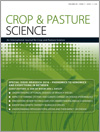
Crop and Pasture Science
Volume 69 Number 1 2018
Brassica 2016 – Phenomics to Genomics and Everything in Between
CP16404Changes in farming practices impact on spore release patterns of the blackleg pathogen, Leptosphaeria maculans
Changes in farming practices such as inter-row sowing, has impacts on stubble retention such that some stubble remains standing at the start of the following season. Spore release patterns for the blackleg fungus, Leptosphaeria maculans, are delayed as well as reduced in standing stubble compared to laying down stubble. These changes in spore release patterns has the potential to impact of disease epidemiology.
CP16445Host–pathogen interactions in relation to management of light leaf spot disease (caused by Pyrenopeziza brassicae) on Brassica species
Light leaf spot (caused by Pyrenopeziza brassicae) is an increasingly damaging disease of oilseed rape (Brassica napus) and vegetable brassicas. This paper reviews the disease epidemiology, pathogen population structure and host range, and disease management strategies. Use of new genomic information to improve understanding of the molecular interactions between B. napus and P. brassicae and of the pathogen population structure is discussed.
CP16445 Abstract | CP16445 Full Text | CP16445PDF (918 KB) Open Access Article
CP16411Changes in allele frequencies of avirulence genes in the blackleg fungus, Leptosphaeria maculans, over two decades in Australia
Avirulence allele frequencies change in response to selection pressure from sowing of cultivars with the corresponding major gene resistance. Analysis of 2091 isolates collected over the past 20 years shows how allele frequencies have changed in Australia in response to cultivar use and which major resistance genes are at risk of being overcome in the field.
CP16468The role of FLOWERING LOCUS C in vernalization of Brassica: the importance of vernalization research in the face of climate change
This review summarises the literature to date regarding vernalization research in Brassicaceae, providing both a historical context and current understanding of the molecular mechanisms involved. We cover the evolutionary conserved biology between the model organism Arabidopsis thaliana and Brassica genus crops and contrast the differences between the genera to show the importance of Brassica-specific research into vernalization.
CP16401Insights into fighting against blackleg disease of Brassica napus in Canada
ToC Abstract: Blackleg is the most serious disease in canola in western Canada. The review highlights the present issues faced by growers and the industry due to the blackleg disease. The review also highlights a new strategy, R-gene rotation introduced to suit the Canadian situation in order to mitigate the disease and increase yield.
CP16401 Abstract | CP16401 Full Text | CP16401PDF (962 KB) Open Access Article
CP16351Development of an ultrasound-assisted extraction method for the rapid quantification of seed carotenoid content in oilseed rape
The nutritional value of rapeseed oil is significantly improved by breeding new cultivars with high seed carotenoid content, successful development of an efficient method for the quantification of carotenoids in oilseed rape is a prerequisite for this breeding initiative, a rapid, accurate, simple and low cost protocol was successfully developed by using ultrasound-assisted extraction.
CP17161Agricultural selection and presence–absence variation in spring-type canola germplasm
Spring canola is a very young crop type, less than fifty years old. Australian and Chinese spring canola look different but are very similar genetically, although with many deletions and duplications of chromosome segments. These chromosome deletions and duplications, coupled with strong inbreeding and selection for different traits, may have helped shape spring canola in China and Australia.
CP17140Detection, prevalence and severity of upper canopy infection on mature Brassica napus plants caused by Leptosphaeria maculans in Australia
Infection of flowers, peduncles, siliques, main stems and branches of canola by Leptosphaeria maculans has increased in prevalence and severity in Australian canola-growing regions since 2011. The term upper canopy infection is proposed to encompass these symptoms as they generally occur together on the same plant and appear after the plant has undergone elongation. Earlier onset of flowering is a key risk factor for more severe upper canopy infection, however, host genetic resistance may be an effective control strategy.
CP17214Genome-wide identification and comparative analysis of NBS-LRR resistance genes in Brassica napus
NBS-LRR genes play an important role in plant disease resistance. We have identified and characterised these genes in three cultivated Brassica species and found that many were clustered and duplicates. These genes are valuable for identification of disease resistance genes underlying QTL or GWAS regions.
CP17193Introgression of allelic diversity from genetically distinct variants of Brassica rapa into Brassica napus canola and inheritance of the B. rapa alleles
Brassica napus × B. rapa interspecific crosses were made to introgress exotic alleles from B. rapa into B. napus canola. Progeny of this interspecific cross stabilised into B. napus type only. Of the theoretical expected number of SSR alleles of B. rapa, only 45% of the alleles were detected in F4 and F8 plants suggesting that the loss of alleles occurred prior to the F4 generation. Genetically distinct canola quality lines were developed from these interspecific crosses by using genetically diverse B. rapa lines in the crosses.
CP17394Identification of DNA methylated regions by using methylated DNA immunoprecipitation sequencing in Brassica rapa
We identified the methylated regions in two Chinese cabbage inbred lines (Brassica rapa) by MeDIP-seq (methylated DNA immunoprecipitation sequencing). Differentially methylated regions between the inbred lines were analysed. We found genes having DNA methylation in intron and 200 bp upstream and downstream regions tended to be silenced, and this heavy methylation was targeted at the interspersed repeats regions such as transposable elements or repetitive sequences within these regions.



